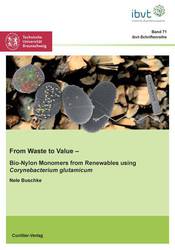| Fachbereiche | |
|---|---|
| Buchreihen (96) |
1378
|
| Nachhaltigkeit |
3
|
| Gesundheitswesen |
1
|
| Geisteswissenschaften |
2364
|
| Naturwissenschaften |
5406
|
| Mathematik | 229 |
| Informatik | 319 |
| Physik | 980 |
| Chemie | 1363 |
| Geowissenschaften | 131 |
| Humanmedizin | 243 |
| Zahn-, Mund- und Kieferheilkunde | 10 |
| Veterinärmedizin | 108 |
| Pharmazie | 147 |
| Biologie | 835 |
| Biochemie, Molekularbiologie, Gentechnologie | 121 |
| Biophysik | 25 |
| Ernährungs- und Haushaltswissenschaften | 45 |
| Land- und Agrarwissenschaften | 1004 |
| Forstwissenschaften | 201 |
| Gartenbauwissenschaft | 20 |
| Umweltforschung, Ökologie und Landespflege | 148 |
| Ingenieurwissenschaften |
1793
|
| Allgemein |
98
|
|
Leitlinien Unfallchirurgie
5. Auflage bestellen |
|
Erweiterte Suche
From Waste to Value (Band 71)
Bio-Nylon Monomers from Renewables using Corynebacterium glutamicum
Nele Buschke (Autor)Vorschau
Leseprobe, PDF (480 KB)
Inhaltsverzeichnis, PDF (72 KB)
For the first time, 1,5-diaminopentane (polyamide monomer) production from xylose was achieved by a recombinant Corynebacterium glutamicum strain. Via rational metabolic engineering the product yield was increased by 54% and the productivity by 100%. The tailor-made strain finally accumulated 103 g L-1 diaminopentane in a fed-batch fermentation, the highest titer ever obtained on xylose. In a two-step process hemicellulose was used as substrate. The monosaccharides were first obtained by hydrolysis and then further used as substrate for the production of
1,5-diaminopentane. Another resource tested was black liquor, a major industrial waste from pulp and paper manufacturing. It turned out that pre-treatment of the black liquor is necessary to obtain bioavailable sugars for subsequent production. The optimized C. glutamicum strain grew well on the black liquor hydrolysate and efficiently converted the containing carbon into 1,5-diaminopentane. The achieved product yield was about 120 % higher than on pure xylose. In this regard, the present work displays a milestone in industrial strain- and bioprocess engineering of C. glutamicum.
Die Herstellung des Polyamidmonomers, 1,5-Diaminopentan, aus Xylose, wurde in dieser Arbeit zum ersten Mal, mit Hilfe eines rekombinanten Corynebacterium glutamicum Stammes realisiert. Durch gezieltes Metabolic Engineering konnte die Ausbeute des Stammes um 54%, die Produktivität um 100 % gesteigert werden. In einer Fed-Batch Fermentation wurde mit diesem maßgeschneiderten Stamm 103 g L-1 Diaminopentane, die höchste jemals erreichte Konzentration auf Xylose, produziert. In einem zweistufigen Prozess wurde anschließend Hemicellulose als Substrat für die Produktion eingesetzt. Die Monosaccharide wurden dabei zunächst in einer enzymatischen Hydrolyse aus der Hemicellulose gewonnen und für die biotechnologischen Produktion von 1,5-Diaminopentan eingesetzt. Als weiterer Rohstoff wurde Schwarzlauge, ein industrieller Abfallstoff aus der Papierindustrie, als Substrat eingesetzt. Es stellte sich heraus, dass eine Vorbehandlung der Schwarzlauge notwendig ist, um die Zucker für die darauf folgende Produktion verfügbar zu machen. Der optimierte C. glutamicum Stamm war in der Lage den Kohlenstoff aus dem Schwarzlauge Hydrolysat zu verstoffwechseln und effizient 1,5-Diaminopentane, mit einer um 120 % gesteigerten Produktausbeute, zu produzieren. Die vorliegende Arbeit repräsentiert daher einen Meilenstein der industriellen Stamm- und Bioprozessentwicklung von Corynebacterium glutamicum.
| ISBN-13 (Printausgabe) | 9783954044573 |
| ISBN-13 (E-Book) | 9783736944572 |
| Buchendformat | A5 |
| Sprache | Englisch |
| Seitenanzahl | 126 |
| Umschlagkaschierung | matt |
| Auflage | 1. Aufl. |
| Buchreihe | Schriftenreihe des Institutes für Bioverfahrenstechnik der Technischen Universität Braunschweig |
| Band | 71 |
| Erscheinungsort | Göttingen |
| Promotionsort | Braunschweig |
| Erscheinungsdatum | 27.06.2013 |
| Allgemeine Einordnung | Dissertation |
| Fachbereiche |
Biologie
|
| Schlagwörter | Schwarzlauge, Abfallstoff, Bioprozessentwicklung, Biotechnologie ,Mikrobiologie und Biotechnologie, 1,5-diaminopentane, xylose, Corynebacterium glutamicum, metabolic engineering, hemicellulose, black liquor, bioprocess engineering, Diaminopentan, Xylose, Corynebacterium glutamicum, Metabolic Engineering, Hemicellulose, Polyamid |








